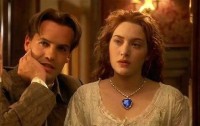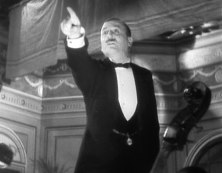
There are only fleeting glimpses of Kurtz when Willard meets him face to face in the closing acts of the film, but the character of Kurtz drives the action of the film from the very beginning.
Well, it’s all to do with films, and here are two films that have MacGuffins in them.
In the 1979 film Apocalypse Now, Captain Benjamin Willard (Martin Sheen) is sent during the Vietnam War on a secret mission up the Nang river through war-torn jungle to assassinate the renegade and insane Colonel Walter Kurtz (Marlon Brando) who has set up camp in a remote abandoned Cambodian temple. And yet in the film, which was directed by Francis Ford Coppola, Kurtz does not appear until two and a half hours have passed, and then is on-screen for only 18 minutes, mainly delivering a rambling monologue.
The opening scenes of the 1997 film Titanic, directed by James Cameron, concerns a treasure hunter Brock Lovett searching the wreck of RMS Titanic for a necklace with a rare blue diamond, the Heart of the Ocean. Lovett’s team recover a safe from the wreck which contains a drawing of a young woman wearing only the necklace. The women in the drawing, Rose Dawson Calvert (played by Kate Winslet when young and Gloria Stuart when old), had survived the sinking and is located and brought aboard the survey ship. She then tells her story of the voyage. The diamond seems at first to play a crucial part in the plot, but the film is actually about a romance between two people, Rose and Jack Dawson (Leonardo DiCaprio) from different social classes set against the sinking of an ‘unsinkable’ ship.

Cal Hockley (Billy Zane) gives Rose (Kate Winslet) the blue diamond necklace as an engagement present. To keep Rose away from Dawson, Hockley has the diamond planted on Dawson, who is then arrested, but the diamond plays little or no further part as the Titanic has already collided with the iceberg.
What both these films have in common is that a character, Kurtz, and an object, the diamond, seem to be of critical importance to the film’s plot, but the main action of the film doesn’t depend on them. Coppola envisioned Apocalypse Now as a definitive statement on the nature of modern war, the difference between good and evil, and the impact of American society on the rest of the world. Kurtz could just as well have been an enemy commander. In Titanic, the diamond could have been a diary or a photograph. Kurtz and the diamond are just catalysts, plot devices to drive the action forward, to get the characters moving, and they are called MacGuffins.
It’s mostly irrelevant what the MacGuffin actually is. It may be an object, a place, or a person. Or it may take more abstract forms such as money, survival, power, love, or some unexplained force. The MacGuffin device is especially common in thrillers. It is usually the focus of the film at the beginning, and thereafter declines in importance.
The term MacGuffin was originally popularized by Alfred Hitchcock, and his first recorded usage was in a lecture that he gave at Columbia University on 30 March 1939.
We have a name in the studio, and we call it the ‘MacGuffin’. It is the mechanical element that usually crops up in any story. In crook stories it is always the necklace and in spy stories it is always the papers. We just try to be a little more original.
For Hitchcock, the MacGuffin is the engine that sets the story in motion; it serves as a pivotal reason for the suspense to occur.

In the theatre, Hannay asks Mr Memory ‘what are the Thirty-Nine Steps?’. Mr Memory compulsively answers that it is a secret organisation of spies but is shot before he can finish. Backstage, the dying Mr Memory recites the details of the aircraft engine he has memorised, the MacGuffin, and says before he dies ‘It was the biggest job I ever tackled …. I’m glad it’s off my mind.’
In The 39 Steps (1935), the MacGuffin is the coveted design for a silent aircraft engine stored in the mind of a vaudeville performer named ‘Mr Memory’ but for the cinema audience the real action is in the hero, Richard Hannay (Robert Donat), being chased up and down the country by police and villains alike.
In Psycho (1960), it is the $40,000 stolen by Marion Crane from an estate agent, though the plot actually centres on the unnerving behaviour of Norman Bates, the proprietor of the Bates Motel. Crane becomes a MacGuffin herself as she is killed less than halfway through the film. In The Lady Vanishes (1938), it is a coded message contained in a tune performed by a folk singer overheard by a guest, Miss Froy, whilst staying at a remote eastern European inn. It is one of the most abstract of Hitchcock’s MacGuffins. The audience however are more interested in the quest of a young English tourist, Iris Henderson, in trying to find Miss Froy, who has mysteriously disappeared on the train that is taking them both back to England.
Hitchcock may have got the idea of the MacGuffin from a brief story told by his friend screenwriter Angus MacPhail, who delighted in wordplay and puzzles, and who at one time earned his living by making up jokes for Tommy Trinder who was a popular comedian at the time.
Two men were travelling on a train from London to Scotland. An odd shaped package sat on the luggage rack above their seat.
‘What have you there?’ asked one of the men.
‘Oh, that’s a MacGuffin,’ replied his companion.
‘What’s a MacGuffin?’
‘It’s a device for trapping lions in the Scottish Highlands.’
‘But there aren’t any lions in the Scottish Highlands!’
‘Well, then, I guess that’s no MacGuffin!’
Earlier versions place the action in the Adirondack Mountains in the USA, rather than Scotland, which is obviously a better location given the choice of name.
In an interview with director François Truffaut in 1967, Hitchcock explained the idea in more detail.
The theft of secret documents was the original MacGuffin. So the ‘MacGuffin’ is the term we use to cover all that sort of thing: to steal plans or documents, or discover a secret, it doesn’t matter what it is. And the logicians are wrong in trying to figure out the truth of a MacGuffin, since it’s beside the point. The only thing that really matters is that in the picture the plans, documents, or secrets must seem to be of vital importance to the characters. To me, the narrator, they’re of no importance whatsoever.